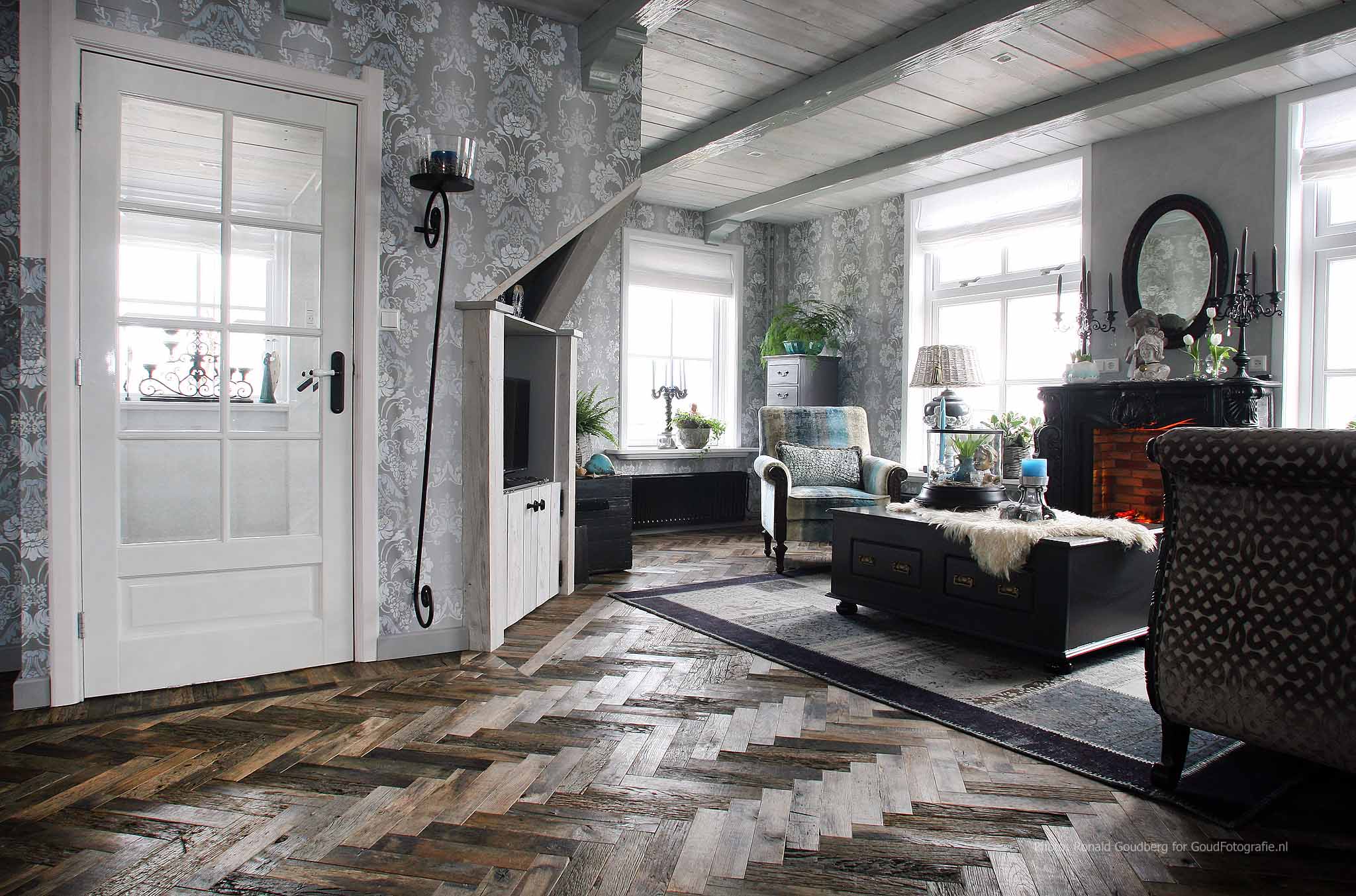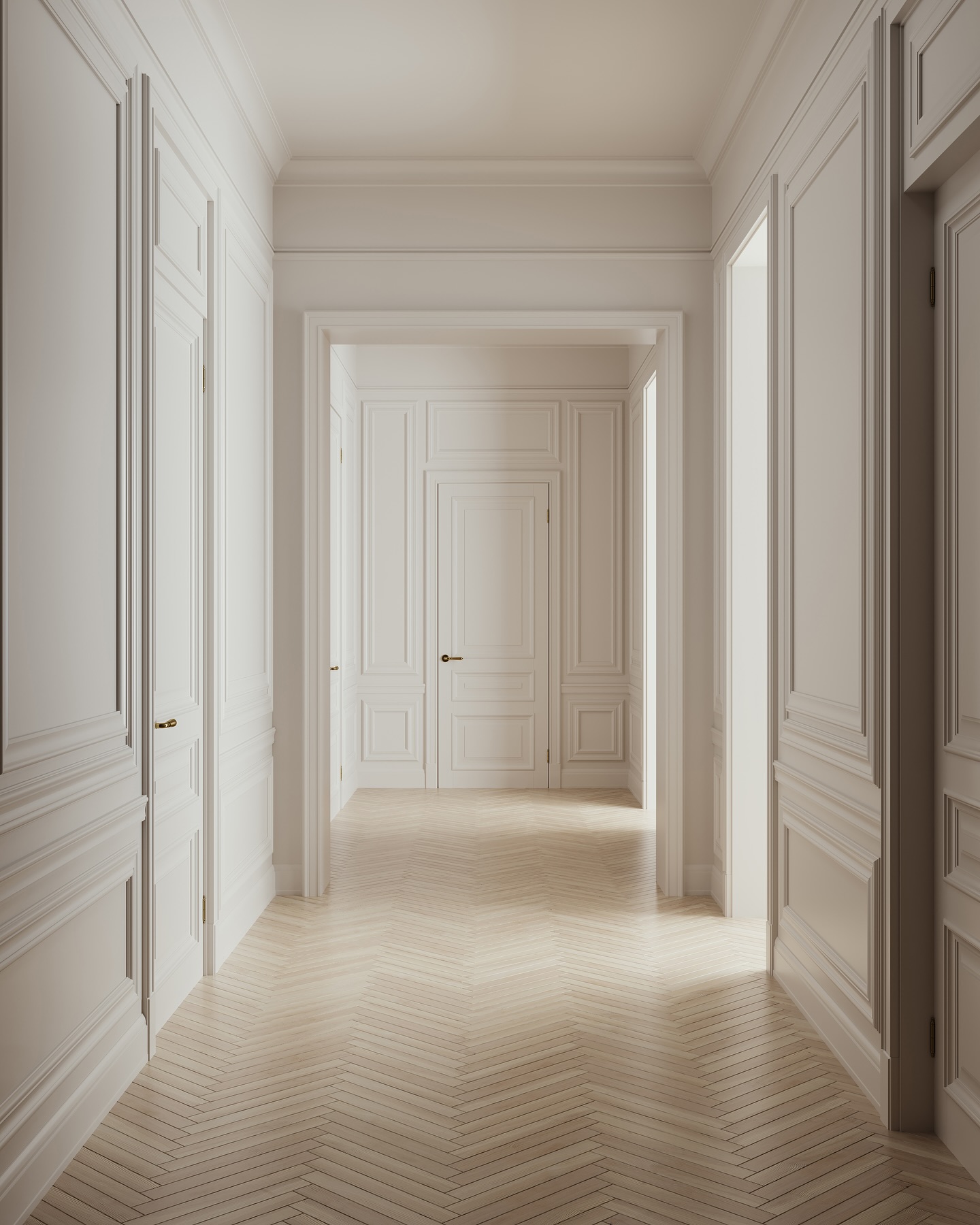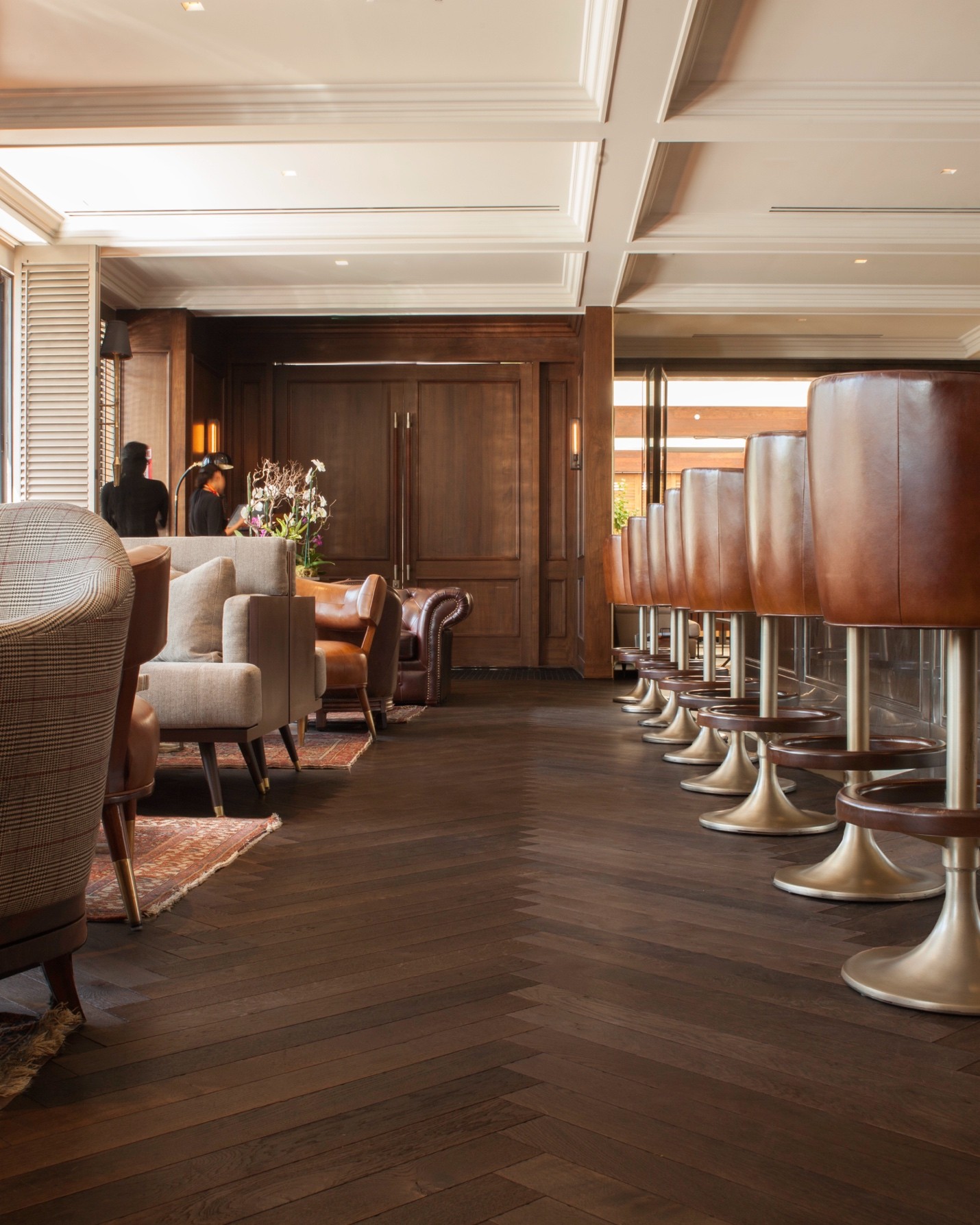
Herringbone Wood Flooring: A Timeless Pattern for Classic and Modern Interiors
Herringbone floors have been used in architecture and interior design for centuries. The elegantand distinctive herringbone pattern, made by laying rectangular planks in a staggered chevronformation that is immediately recognizable. Whether in a Parisian flat or a Brooklyn brownstone,the pattern brings a sense of elegance and timelessness that elevates any space. While trendscome and go, herringbone floors are a foundational aesthetic that suits both contemporary andtraditional interiors.
The herringbone pattern has its earliest roots in ancient Roman road construction, whereinterlocking bricks were laid in a zigzag arrangement to absorb pressure and distribute weight,an approach driven more by function than form. Over time, this practical pattern made its wayindoors, evolving into something both structural and decorative.
In the 16th century, herringbone gained prominence in France, becoming a staple of grandchâteaux and stately homes. Often made of oak or walnut, herringbone parquet flooring wasassociated with wealth and fine craftsmanship, laid by skilled artisans in precise, geometricconfigurations that reflected the era’s cultural emphasis on symmetry and order. One of themost iconic examples is the Palace of Versailles and Château de Fontainebleau, where intricatewood patterns, including early versions of herringbone and the famed square parquet deVersailles, were installed in the 17th century as a statement of royal sophistication andarchitectural ingenuity.
From France, the pattern spread across Europe, appearing in Austrian palaces, Italian villas,and eventually Georgian and Victorian townhouses in London. That legacy endures today ininstitutions like Victoria and Albert Museum in London, where herringbone floors quietly supporta historic display of fine art and furniture.

As a recent example, in her Beverly Hills home, Kelly Wearstler used dark herringbone woodflooring as a unifying element that grounds the eclectic and high-impact design choices layeredthroughout the space. In the entryway, the deep tone of the flooring contrasts beautifully withthe sweeping white staircase and ornate ironwork, creating a dramatic but balanced firstimpression.


In a nearby sitting room, the same herringbone floor carries through, offering a rich base forbold shapes and warm textures. The pattern brings continuity to an interior full of contrasts,allowing classic architectural details to live comfortably alongside contemporary art andfurniture. True to Wearstler’s signature style, the space feels elevated but livable, where vintageand modern design coexist through thoughtful layering, with the timeless herringbone floorquietly holding it all together.
Today, herringbone wood flooring appears in kitchens, bathrooms, dining rooms, bedrooms,and basements, proof of its total adaptability. It’s versatile, even neutral, in the way itcomplements different design styles without dominating them. Whether paired with minimalistinteriors, traditional furniture, or modern architecture, the herringbone pattern continues toconnect the past with the present in a way that feels effortless and enduring.
When selecting herringbone floors, one of the first choices is material. Options include solidhardwood, reclaimed wood, engineered wood, and wood veneer. Each has its strengths,depending on budget, installation needs, and long-term use.
Solid hardwood, like red oak or walnut, is prized for its natural beauty and longevity.Herringbone hardwood floors made from solid oak are among the most classic combinations.Oak is durable, stains well, and has a grain that enhances the overall pattern. Red oak, with itsrich undertones, is often chosen for warm interiors. Solid hardwood floors, especially unfinishedversions, can be sanded and refinished multiple times, making them a great option for hightraffic commercial spaces, and an excellent investment for residential projects.
Reclaimed oak herringbone flooring brings character to a space, with its texture and naturalvariation that cannot be replicated with new materials. In this living room, the floor sets the tonefor an eclectic interior layered with antique-style furniture and damask wallpaper. The aged oakplanks reveal a patina of wear, knots, grain, and tonal shifts that speak to decades of use andpreservation. Reclaimed wood is also a sustainable choice, giving new life to old materials whileoffering the kind of authenticity that is hard to replicate. Whether in a rustic cottage or a citytownhouse, reclaimed oak herringbone is a statement in craftsmanship, warmth, and timelessappeal.

Engineered wood is a solution for many renovation projects. Made from a hardwood veneer ona plywood or composite core, engineered herringbone wood flooring offers stability with lesssusceptibility to expansion like solid hardwood, due to humidity or heat. It’s ideal for kitchens,bathrooms, or anywhere underfloor heating is used. Engineered herringbone wood floors allowfor that traditional aesthetic, with the added flexibility of use in environments where solidhardwood might not hold up.
Installing herringbone flooring is a meticulous process. The adhesive used during installationalso matters. Whether working with engineered wood, solid oak, or tile, the right adhesiveensures stability and longevity. Installing natural herringbone flooring differs significantly fromengineered wood in both method and material behavior. Solid hardwood herringbone requirescareful acclimation, typically five to ten days, so the planks can adjust to the room’s humidity,helping to prevent warping or gapping after installation. It’s usually glued down with full-spreadadhesive or nailed to a wood subfloor, and may be finished on site if using unfinished planks,allowing for custom stains and finishes.
In contrast, engineered wood herringbone is more stable and often easier to install. It generallyneeds just two to three days to acclimate and is commonly glued down using flexible adhesives.Many engineered options come pre-cut with tongue-and-groove or click-lock systems, makinglayout and alignment more manageable. Engineered wood is also ideal for homes withunderfloor heating, as it resists expansion and contraction better than solid wood. While bothoptions require a flat, dry subfloor, engineered herringbone tends to be more forgiving and timeefficient, especially when prefinished boards are used.
Color plays a crucial role in defining the overall feel of a space, and flooring is no exception. Anatural oak tone remains one of the most timeless and adaptable options. In this hallway, 2.5”Gold | Herringbone flooring in a natural hard wax oil finish from our Sierra Heartwood Collection with AD designers Pierce & Ward enhances the classical detailing of the space without competingwith it, allowing the intricate paneling, brass hardware, and soft light to take center stage.Whether used in a modern, minimalist home or a more traditional setting, natural oakherringbone provides a neutral, elevated foundation. It reflects light beautifully, works withvirtually any color palette, and subtly reinforces the design language of the space, making it afavorite for interiors that aim for both elegance and longevity.

Playing with finishes, like greys or taupes, can work well for a monochromatic look, especiallyfor a Scandinavian aesthetic. In an industrial or loft-like space with concrete walls, exposedbeams, or metal finishes, grey herringbone floors can soften the look while keeping everythingtonal.
Darker stains like espresso or mahogany-finished herringbone floors are deep, rich, and bold,ideal for traditional spaces or when you want to ground a space with warmth and character.These darker finishes are timeless, but they work best in certain contexts where their depthadds sophistication and gravitas. Think of formal spaces like a library or home office, withsimilarly rich furniture.
At Baltaire Restaurant in Los Angeles, espresso-stained herringbone flooring demonstrates howa deep finish can bring refinement and cohesion to a large space. The dark wood anchors theroom, complementing the paneled walls and traditional furniture. Despite the richness of thefloor, the space feels open and balanced, thanks to ample natural light, a warm neutral palette,and thoughtful material contrasts like brass, leather, and soft upholstery. Here, the herringbonepattern isn’t the focal point, but rather a foundational detail that elevates the overall design.

When planning across large square footage (whether in a single room or throughout a home),it’s worth considering how the chosen colour interacts with light. North-facing rooms, forexample, benefit from warmer tones. Cooler shades work well in sunlit areas.
The width of the planks used in herringbone flooring can significantly influence the overallaesthetic and feel of a space. Narrow planks create a finer, more intricate pattern that oftenreads as classic or traditional, ideal for smaller rooms or formal settings where detail is key. Onthe other hand, wider planks feel more modern and relaxed. They work well in open-conceptspaces or contemporary interiors where you want the pattern to feel intentional but not overlyornate. The scale of the room, ceiling height, and overall style should all factor into the decision.Narrow planks add delicacy, while wide planks bring drama and a sense of architecturalconfidence.
The herringbone pattern isn’t just a visual choice; it also offers several practical benefits.Herringbone wood flooring, particularly in engineered or solid hardwood, is highly durable andholds up well over time. Its layout helps camouflage everyday wear in high-traffic rooms,concealing scratches and imperfections more effectively than standard straight planks. Beyondfunctionality, herringbone hardwood floors add long-term value; many buyers view the patternas a mark of craftsmanship and a nod to architectural tradition, offering a sense of continuitybetween past and present.
Sustainability is a growing priority for many homeowners, and herringbone flooring aligns wellwith that shift. Engineered wood uses hardwood more efficiently than traditional planks,reducing the demand for solid oak or walnut while maintaining the same visual impact.Choosing FSC-certified materials, low-VOC adhesives, and water-based polyurethane finishescan further minimize environmental impact. Longevity also plays a role in sustainability—herringbone wood floors, when properly installed, can last for generations. And while interiorstyles may change, the pattern’s enduring appeal means it rarely needs replacing, making it oneof the most sustainable design choices available.
Different rooms present different flooring needs, and the herringbone pattern adapts well acrossthe entire home. In dining rooms, it adds a sense of formality to entertaining spaces. In kitchens,engineered wood combined with the right adhesive brings warmth and durability to one of themost frequently used areas. Bedrooms benefit from the soft look of herringbone flooring,especially in taupe or blonde oak tones.
From its ancient origins to its modern versatility, herringbone flooring has proven itself to be farmore than a design trend: it’s an aesthetic choice that continues to adapt to the needs ofcontemporary living. Whether made from solid hardwood or engineered wood, installed in aformal dining room or a minimalist kitchen, herringbone wood flooring offers a combination ofdurability, style, and longevity. Its wide range of finishes, compatibility with underfloor heating,and sustainability credentials make it as practical as it is beautiful. With the ability tocomplement both traditional and modern interiors, the pattern remains a timeless foundation forspaces of all kinds.
In many ways, herringbone flooring sets the tone for a space. It introduces a sense of formalityand craftsmanship from the ground up, and yet, it never feels restrictive. Whether paired withclean-lined contemporary furniture or layered with vintage textiles and antique pieces, theherringbone pattern is the ultimate way to elevate a space. That’s why it remains a favoriteamong interior designers and architects: it creates visual interest and works seamlessly with awide range of aesthetics. It’s also a smart long-term investment, timeless in look, durable inbuild, and compatible with sustainable choices like engineered wood and reclaimed wood. Forhomeowners who want a floor that feels considered but not overly styled, refined but still livable,herringbone offers that rare combination.
Is herringbone flooring more expensive to install?
Yes, herringbone flooring is generally more expensive to install than standard plank flooring.The intricate pattern requires precise layout, additional cutting, and skilled labor to ensureproper alignment. Installation takes longer and often results in higher labor costs. However, thevisual impact and long-term value often justify the investment.
Can herringbone floors be used with underfloor heating?
Yes, herringbone floors—particularly engineered wood herringbone—are well-suited for usewith underfloor heating systems. Engineered wood is more dimensionally stable than solidhardwood, which helps it withstand fluctuations in heat and humidity. Always consult yourflooring manufacturer for compatibility and installation guidelines.
Is reclaimed wood suitable for herringbone patterns?
Absolutely. Reclaimed wood is an excellent choice for herringbone flooring. Its natural variation,aged texture, and patina add character and authenticity to the pattern. Reclaimed oak isespecially popular due to its durability and rich visual depth. Keep in mind that installationrequires careful sorting and precision, but the result is a one-of-a-kind floor with history andsustainability built in.
What is the difference between herringbone flooring and chevron flooring?
The main difference lies in the angle and alignment of the planks.
uses rectangular planks arranged in a staggered zigzag pattern, wherethe ends of the boards meet at a 90-degree angle.
features planks cut at an angle (typically 45° or 60°), so they form acontinuous V shape when joined point to point. Chevron has a more seamless, directional look,while herringbone offers a broken, more textured visual rhythm.